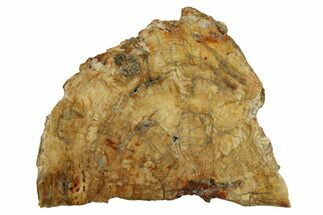This Specimen has been sold.
4.85" Tall Colorful Petrified Wood Bookends - Madagascar
This is a pair of bookends made from richly colored, 220-million-year-old petrified wood (Araucaria), imported from Madagascar. The sides have been lined with felt and the display faces are polished to a glossy finish.
Each bookend slightly varies in size. The larger measures 4.85" tall, 3.6" wide and 1.9" thick, and the smaller is 4.6" tall, 3.5" wide and 1.9" thick.
Each bookend slightly varies in size. The larger measures 4.85" tall, 3.6" wide and 1.9" thick, and the smaller is 4.6" tall, 3.5" wide and 1.9" thick.
What Is Petrified Wood
Petrified wood is the name given to wood that has been turned into stone (fossilized) through the process of permineralization. In this process, all of the organic matter becomes replaced by minerals, while much of the original structure, such as tree rings, is retained. For this to happen, the wood needs to be buried in an environment low in oxygen to prevent decomposition and with flowing, mineral-laden water, so minerals may replace structures. The coloration is caused by various minerals that present in that water during fossilization. For example, red colors are due to iron compounds, greens due to copper, and so on.
Petrified wood is the name given to wood that has been turned into stone (fossilized) through the process of permineralization. In this process, all of the organic matter becomes replaced by minerals, while much of the original structure, such as tree rings, is retained. For this to happen, the wood needs to be buried in an environment low in oxygen to prevent decomposition and with flowing, mineral-laden water, so minerals may replace structures. The coloration is caused by various minerals that present in that water during fossilization. For example, red colors are due to iron compounds, greens due to copper, and so on.
SPECIES
Araucaria (Conifer)
LOCATION
Ambilobe, Madagascar
FORMATION
Isalo II Formation
SIZE
4.85 x 3.6", 1.9" thick
CATEGORY
SUB CATEGORY
ITEM
#303574
We guarantee the authenticity of all of our specimens.
 Reviews
Reviews











